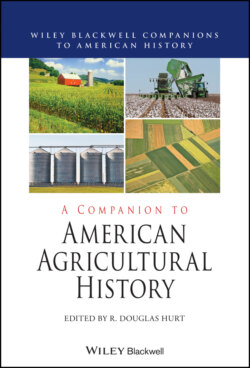Читать книгу A Companion to American Agricultural History - Группа авторов - Страница 17
The Southwest BEGINNINGS OF MAIZE CULTIVATION
ОглавлениеHunter-gatherer groups in the Southwest were thinly scattered across the landscape before some of them began planting maize no later than 2100 BCE. Sites yielding early maize are located at both lower and higher elevations in the Sonoran Desert of southern and central Arizona and Sonora, the Mogollon Highlands of southwestern New Mexico, and the Colorado Plateau where the states of Utah, Colorado, New Mexico, and Arizona meet in a point giving its name to the Four Corners region (Figure 1.1). What early maize sites have in common is better-than-average access to moisture in the form of high local water tables or proximity to springs, seeps, or rainwater runoff (Hanselka 2017). Maize predating 1000 BCE had small cobs that archaeologists think were relatively low in food value compared to later varieties (L. Huckell 2006).
Mitigation of cultural resources in the right-of-way of Interstate Highway 10 alongside the Santa Cruz River in the Tucson Basin revealed an astonishing cluster of deeply buried, early agricultural settlements dating between 2100 BCE and 100 CE, a time period called the Early Agricultural Period. Canal construction in the Tucson Basin began as early as 1500 BCE (Vint 2017). The site of Las Capas is remarkable due to its associated system of canals and rectangular fields, more than five acres (2 ha) of which were exposed by backhoes with 7-foot wide blades. By the first millennium BCE, an estimated 12.4 acres (5 ha) of land surrounding Las Capas might have been irrigated (Vint 2017).
Occupation of the Santa Cruz floodplain was not necessarily continuous throughout the entire 2000-year time frame called the Early Agricultural Period, and degree of sedentariness, even during stretches of optimal climate, is a topic debated by archaeologists (Roth 2016; Vint 2017). Faunal and floral remains reflect a pattern of logistic mobility that included the hunting and harvesting of wild resources, without evidence for significant pressure on either large or small animals. Maize is estimated to have contributed approximately 30 percent of caloric intake on an annual basis, with amaranth and other weedy plants encouraged in and near fields as supplemental foods (Vint 2017).
The Tucson Basin was not the only place in the Southwest where early farming communities practiced irrigation. Similarly ancient canals have been found at La Playa in northern Sonora, Mexico, and at a site dating to 1000 BCE near Zuni in western New Mexico (Damp, Hall, and Smith 2002; Hanselka 2017). Terraces (trincheras) built on hills in southern Arizona and northern Chihuahua demonstrate another form of organized communal labor. Cerro Juanaqueña is a prime example, with nearly 500 rock-lined earthen terraces covering the flanks and summit of a 140 m high basalt hill overlooking the fertile Casas Grandes river valley in Chihuahua. The major occupation at Cerro Juanaqueña dates to 1300–1100 BCE, with maize found in 69 percent of the features excavated (Hard et al. 2008). Terraces served as foundations for domestic structures and pits, with crops grown in the river valley below.
Firm evidence for domesticates other than maize in early components is surprisingly rare. Squash (Cucurbita pepo ssp. pepo) as old as 1700 BCE has been reported from McEuen Cave in the Gila Mountains of eastern Arizona, and fragments predating 500 BCE came from two sites—Sheep Camp Shelter and Bat Cave—in New Mexico (Hanselka 2017, table 15.2). Bottle gourd (Lagenaria siceraria) phytoliths were reported from field sediments at Las Capas (Vint 2017). Common beans (Phaseolus vulgaris) were apparently not grown by the earliest southwestern food producers, which is not surprising in light of the late initial domestication date for beans—c. 300 bce—in Mesoamerica (Kaplan and Lynch 1999).
